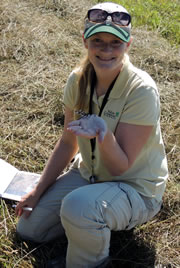Any bird you can spot, I can spot better: My backyard bird bonanza
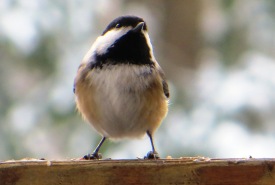
Chickadee at feeder (Photo by Kaitlyn Finnegan)
As I washed dishes at my kitchen sink I saw a flicker out of the corner of my eye. By the time I looked up, my backyard and the high wooden birdfeeder filled with sunflower seeds were both perfectly still and empty. I looked back to the sink and a moment later there it was again — a distinctly black and white flutter, and this time the branch of a willow tree was waving. Peering more closely at the branch, I saw a white, clown-like face munching away. It was a white-breasted nuthatch and I was fairly certain it was eating a sunflower seed.
I dried my hands and watched him closely. Sure enough, as soon as it was finished with the seed, it darted to the wooden feeder, landed for just a moment to grab another one and flew back to the safety of the tree to swallow it down.
A couple of months later, I am very familiar the nuthatch’s signature darting move, along with the varying behaviours of the other birds that have visited my feeder since I started keeping count on January 1, 2014. I am working on my “house list” for the year, and gearing up for my participation in the Great Backyard Bird Count — a citizen science initiative launched in 1998 by the Cornell Lab of Ornithology and the National Audubon Society that involves counting the number and species of birds that visit your backyard for one weekend in winter (this year, February 14-17).
I watched with delight on New Year's Day as a red-bellied woodpecker, the first of its species to visit since I moved into my house four years ago, greedily battled away a hungry European starling from the suet feeder it was intent not to share. I have enjoyed American goldfinches staging turf wars on the window feeder that looks right into my living room. You can almost imagine them yelling, “I was here first... back off!!” as they squawk, beaks agape.
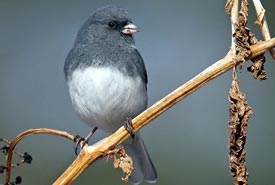
Dark-eyed junco (Photo by Bill Hubick)
I equally enjoy the patient work of the dark-eyed juncos, who simply mill about under the tall feeders and peck the seeds off the ground that the other birds have scattered about during their frenzied feeds. Mourning doves employ a similar strategy, bouncing lazily about on the snow, or sometimes just perching squatly, puzzlingly, on top of the feeder (some people believe they’re not the brightest birds, but they do look cozy all hunkered down to keep warm against the winter winds).
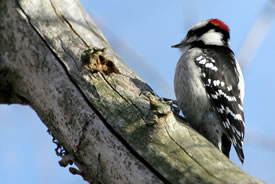
Downy woodpecker (Photo by Bill Hubick)
American tree sparrows have showed up in hordes, identifiable by a dark spot on their breast and a fuzzy red faux-hawk. But I’ve also picked up my binoculars a number of times only to be disappointed that the “little brown job” at the feeder is just another house sparrow. This species is non-native and tends to be a bit of a feeder hog, and the males have rather angry little faces. I have occasionally done a double take at the suet feeder, which hosts a daily downy woodpecker or two, only to find that the downy’s larger, shier relative, the hairy woodpecker, has actually come to dine instead.
There is nothing more cheerful than the flashes of vibrant blues of jays and reds of cardinals on the greyest days of winter, when the landscape is painted in stark monochrome. However, I realized towards the middle of January that I was still waiting on the northern cardinals. Usually Mr. and Mrs. Cardinal (as my grandmother, mother, and now I, always refer to a mating pair) make regular appearances throughout all the seasons at my feeders. I earmarked them as one to watch out for, and had just pulled out my camera to take a few snaps of my woodpecker friends, when lo and behold, Mr. Cardinal made an appearance at the southern feeder.
Adding a new species to my list was thrilling, as was seeing my familiar friend warming my backyard with his presence during a particularly frosty winter.
Several weeks ago, I challenged Christine Beevis Trickett to a “bird-off” to see how many species we might each see at our feeders this winter — hers in Calgary, Alberta and mine in Guelph, Ontario. A tad competitive in nature, I decided to make my own homemade suet to ensure that I enticed the widest audience of diners to my feeders and show Christine who was boss.
One pot of saved fat drippings, a squishy cup of peanut butter, dash of cayenne pepper and bags of bulk food items later, my kitchen smelled like a rendering facility, my counters were smeared with bright orange grease and birdseed was scattered everywhere. Chopping the frozen suet into cakes to fit my suet feeder with a very sharp knife was a slimy misadventure that nearly had me admitting defeat, but the effort was worth it when I wrangled the suet into the feeder and the next day saw my friendly neighbourhood downy woodpecker happily pecking away at it.
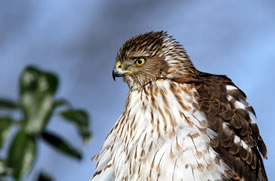
Cooper's hawk (Photo by Bill Hubick)
Hopefully my backyard visitors are ready for a feast this weekend when I’ll keep an eye on them and record my findings for another worldwide citizen science birding extravaganza. A Cooper’s hawk swooped through my backyard a few weeks back and I’m hoping for another similar exciting find! Or even if I just count 25 goldfinches, I’ll be happy to have kept these little guys fed through a cold winter, and to have shared important bird data to further inform what we know about our feathered friends.
Come back soon to see how Christine fared in our bird-off competition!

